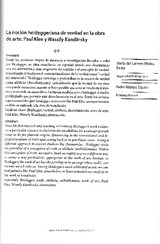La noción heideggeriana de verdad en la obra de arte: Paul Kleey Wassily Kandinsky
Autor
Molina Barea, María del Carmen
Mantas España, Pedro
Editor
Asociación Andaluza de FilosofíaFecha
2010Materia
Heidegger, Martin 1889-1976Verdad
Alétheia
Desvelamiento
Obra de arte
Klee, Paul 1879-1940
Kandinsky, Wassily 1866-1944
Abstracción
Truth
Unhiddenness
Work of art
Abstraction
METS:
Mostrar el registro METSPREMIS:
Mostrar el registro PREMISMetadatos
Mostrar el registro completo del ítemResumen
Desde las primeras etapas de docencia e investigación llevadas a cabo
por Heidegger, su obra manifiesta un especial interés por desentrañar
una vía alternativa y más originaria del sentido y el concepto de verdad.
Repudiando el tradicional convencionalismo de la verdad como "verdad
del enunciado", Heidegger investiga y profundiza en Ia noción de verdad
como alétheia (desvelamiento); entendiendo que la verdad de un ente
sólo puede conocerse cuando se hace posible que ente se revele en sí mismo
y se desvele su naturaleza. En buena medida, para Heidegger el medio
privilegiado que permite este desvelamiento es el arte. Entre los artistas
más reconocidos por Heidegger se encontraba Paul Klee, aunque nuestro
análisis se extiende a la obra de Kandinsky. Since his first research and teaching at Freiburg, Heidegger’s work evidences a particular concern to elucidate the possibilities for a concept of truth closer to its pre-platonic origins. Renouncing to the conventional and logical conception of truth and coming back to its pre-classic roots -trying a different approach to ancient thinkers like Parmenides-, Heiddeger study the potential of a conception of truth as alétheia (unhiddenness). Within this conception of truth, we need to think on reality in a very different way or sense: a way particularly appropiate to the work of art, because, to Heidegger, the work of art has the privilege to be an stage where reality can become unveil onto us. Among Heidegger’s most celebrated artists we can find painters like Paul Klee, nevertheless we have extended our analysis to the work of Kandinsky.

